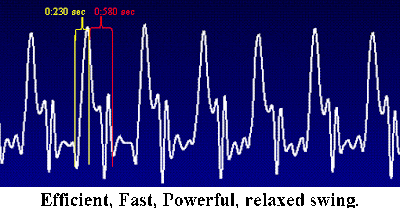"The language of Movement is feel" -- Gray Cook
When people find out that I regularly have people swing kettlebells on a force plate, the first question I always get is "how do I compare to _________?" With a little time and math I can pretty much tell everyone how they rate compared to - say - Pavel (whose name typically fills that blank most often). While that is good information to have, what can people do with it?
More importantly how will that improve their swing? My opinion: knowing your power output won't do anything to improve your technique.
Often times when trying to fix someones technique, we ask the question "how does that feel" or "do you feel the difference?" If someone can't feel what they are doing, how can they feel what they are doing differently? The immediate feedback the force plate gives -that I overlooked until recently- is immediate feedback on swing technique. For example, this is an example of what a swing looks like graphed out on the force plate:
What this shows is the vertical forces associated with the swing in a graph format. Essentially, it allows me to see the forces being generated during the swing as they are happening - it shows me what you feel. Does your swing feel smooth or jerky? Powerful or weak? Fast or Slow? I can tell you what you feel, then show you what you feel. The swing depicted above is a very smooth swing, a very efficient swing, and a very powerful swing. It also happens to be the swing of
Master RKC Brett Jones. You will notice how smooth the curves are, not a lot of jagged edges - this tells me that he is efficiently
cycling between tension and relaxation. Notice that during the float phase - when the bell is at the top of the swing and floating- the line is relatively flat. This is Brett
appreciating his swing - a moment of "controlled" relaxation where there is little to application of force. You will also notice how the peak of the down portion (bottom) of the swing is much higher than the peak of the up swing (the peak right before hip EXT). This is because significantly higher eccentric forces are created by Brett than concentric forces. Remember Pavel and all the Master's emphasizing having an a
ctive down swing where you are actively hiking the bell down and back? This is what they want to see. Why this is important and how this benefits the force produced during the up swing will be discussed in a later article.
Now, lets dissect
Pavel's swing:
First, look at how similar each peak and valley looks. That is consistency thru mastery. Each of Pavels swings are identical to each other. Next, his down swing takes approximately 1/4 or a second and generates a tremendous eccentric load. That is then followed by an upswing that lasts 1/2 a second. Which, because of how quickly the transition from eccentric to concentric occurs Pavel is able to
utilize a large amount of the energy he stored during the down swing to power his up swing - think along the lines of a plyometric activity. One difference you will see between Pavel and Brett's swing is that Brett exhibits a "quieter" float phase - which shows that at the top of the swing Brett is better able to relax. Pavel again exhibits consistency during his float phases -they all look the same.
Now lets look at a bad swing:
Problem #1 - the down swing is horrible. Notice how there is no consistent peak. This is a very slow swing (the down swing was twice as long as Pavels) which leads to a loss of energy -as heat (again like plyometrics). This person also has quite a bit of variability between each swing.
Problem #2- the float phase does not exhibit any relaxation, and is not consistent. With Pavel, he had some activity but it was consistent activity. This person does a poor job generating tension, has trouble relaxing, and demonstrates no mastery of the swing. Their swing might look good, but probably feels very challenging for them - to the point that they get gassed with high volume swings (and even snatches).
Problem# #3 - This is a very slow swing. From start to finish, one swing cycle takes approximately 1.20 seconds to complete - not counting the float phase. Pavel took 0.750 seconds, and the Iron Tamer Dave Whitley (Master RKC) takes 0.810 seconds. This has a dramatic effect on the power that is generated. Essentially, slow swings generate less force that fast swings.
So lets end on a good note - breaking down the
Iron Tamers swing.
Not surprisingly, Mr. Whitley has a textbook swing. Each of his swings is identical to the previous. The eccentric portion took less than 1/4 second, and the concentric portion took just over 1/2 second. His float phase isn't as relaxed as Brett's, but like Pavel there is consistency.
The commonality between all three - Pavel, Brett, and Dave - is the speed of their swing. All three took around 0:750 seconds to complete one swing cycle. We could get into the whole physics of this but essentially with increased swing speed -
especially on the downswing - and consistency, power will be there. BUT the other commonality is the float phase - there
has to be a controlled relaxation portion of the swing.
Finally, what everyone wants to know: Who generated more force? That will come next time, so stay tuned. I've never claimed to be good at math, so I need to round up some extra fingers and toes to get those numbers.






